Extraction of Phenolic Compound from Model Pyrolysis Oil Using Deep Eutectic Solvents: Computational Screening and Experimental Validation
Abstract
:1. Introduction
2. Computational Methodology
Geometry Optimization
3. Materials and Methods
3.1. DES Synthesis and Characterization
3.2. Liquid–Liquid Extraction
4. Results and Discussion
4.1. Computational Screening Using COSMO-RS
4.2. Physical Properties of DES
4.3. Experimental Results
4.4. Consistency Test
5. Conclusions
Supplementary Materials
Author Contributions
Funding
Institutional Review Board Statement
Informed Consent Statement
Conflicts of Interest
References
- Venkata Mohan, S.; Pandey, A. Chapter 1—Sustainable Hydrogen Production: An Introduction. In Biohydrogen, 2nd ed.; Pandey, A., Mohan, S.V., Chang, J.-S., Hallenbeck, P.C., Larroche, C., Eds.; Elsevier: Amsterdam, The Netherlands, 2019; pp. 1–23. [Google Scholar]
- Yang, H.; Yao, J.; Chen, G.; Ma, W.; Yan, B.; Qi, Y. Overview of upgrading of pyrolysis oil of biomass. Energy Procedia 2014, 61, 1306–1309. [Google Scholar] [CrossRef] [Green Version]
- Salleh, M.Z.M.; Hadj-Kali, M.; Wazeer, I.; Ali, E.; Hashim, M.A. Extractive separation of benzene and cyclohexane using binary mixtures of ionic liquids. J. Mol. Liq. 2019, 285, 716–726. [Google Scholar] [CrossRef]
- Mulyono, S.; Hizaddin, H.F.; Wazeer, I.; Alqusair, O.; Ali, E.; Hashim, M.A.; Hadj-Kali, M.K. Liquid-liquid equilibria data for the separation of ethylbenzene/styrene mixtures using ammonium-based deep eutectic solvents. J. Chem. Thermodyn. 2019, 135, 296–304. [Google Scholar] [CrossRef]
- Hadj-Kali, M.K.; Al-Anazi, A.M.; Alhawtali, S.M.; Wazeer, I. Liquid-liquid separation of n-hexane/1-hexene and cyclohexane/cyclohexene using deep eutectic solvents. J. Mol. Liq. 2021, 344, 117776. [Google Scholar]
- Mulyono, S.; Hizaddin, H.F.; Alnashef, I.M.; Hashim, M.A.; Fakeeha, A.H.; Hadj-Kali, M.K. Separation of BTEX aromatics from n-octane using a (tetrabutylammonium bromide + sulfolane) deep eutectic solvent—experiments and COSMO-RS prediction. RSC Adv. 2014, 4, 17597–17606. [Google Scholar] [CrossRef]
- Hadj-Kali, M.K.; Althuluth, M.; Mokraoui, S.; Wazeer, I.; Ali, E.; Richon, D. Screening of ionic liquids for gas separation using COSMO-RS and comparison between performances of ionic liquids and aqueous alkanolamine solutions. Chem. Eng. Commun. 2020, 207, 1264–1277. [Google Scholar] [CrossRef]
- Płotka-Wasylka, J.; De la Guardia, M.; Andruch, V.; Vilková, M. Deep eutectic solvents vs ionic liquids: Similarities and differences. Microchem. J. 2020, 159, 105539. [Google Scholar] [CrossRef]
- Wazeer, I.; Hadj-Kali, M.K.; Al-Nashef, I.M. Utilization of deep eutectic solvents to reduce the release of hazardous gases to the atmosphere: A critical review. Molecules 2020, 26, 75. [Google Scholar] [CrossRef]
- Wazeer, I.; AlNashef, I.M.; Al-Zahrani, A.A.; Hadj-Kali, M.K. The subtle but substantial distinction between ammonium-and phosphonium-based deep eutectic solvents. J. Mol. Liq. 2021, 332, 115838. [Google Scholar] [CrossRef]
- Shahbaz, K.; Mjalli, F.; Hashim, M.; AlNashef, I. Using deep eutectic solvents based on methyl triphenyl phosphunium bromide for the removal of glycerol from palm-oil-based biodiesel. Energ Fuel 2011, 25, 2671–2678. [Google Scholar] [CrossRef]
- Tang, B.; Zhang, H.; Row, K.H. Application of deep eutectic solvents in the extraction and separation of target compounds from various samples. J. Sep. Sci. 2015, 38, 1053–1064. [Google Scholar] [CrossRef] [PubMed]
- Rodriguez, N.R.; Requejo, P.F.; Kroon, M.C. Aliphatic–aromatic separation using deep eutectic solvents as extracting agents. Ind. Eng. Chem. Res. 2015, 54, 11404–11412. [Google Scholar] [CrossRef]
- Hadj-Kali, M.K.; Salleh, M.Z.M.; Wazeer, I.; Alhadid, A.; Mulyono, S. Separation of Benzene and Cyclohexane Using Eutectic Solvents with Aromatic Structure. Molecules 2022, 27, 4041. [Google Scholar] [CrossRef] [PubMed]
- Jiao, T.; Qin, X.; Zhang, H.; Zhang, W.; Zhang, Y.; Liang, P. Separation of phenol and pyridine from coal tar via liquid–liquid extraction using deep eutectic solvents. Chem. Eng. Res. Des. 2019, 145, 112–121. [Google Scholar] [CrossRef]
- Jiao, T.; Zhuang, X.; He, H.; Li, C.; Chen, H.; Zhang, S. Separation of phenolic compounds from coal tar via liquid–liquid extraction using amide compounds. Ind. Eng. Chem. Res. 2015, 54, 2573–2579. [Google Scholar] [CrossRef]
- Yi, L.; Feng, J.; Li, W.-Y. Separation of phenolic compounds from coal liquefaction oil by choline chloride-glycerol deep eutectic solvents. Energy Procedia 2019, 158, 5169–5174. [Google Scholar] [CrossRef]
- Li, G.; Xie, Q.; Liu, Q.; Liu, J.; Wan, C.; Liang, D.; Zhang, H. Separation of phenolic compounds from oil mixtures by betaine-based deep eutectic solvents. Asia-Pac. J. Chem. Eng. 2020, 15, e2515. [Google Scholar] [CrossRef]
- Wojeicchowski, J.P.; Ferreira, A.M.; Abranches, D.O.; Mafra, M.R.; Coutinho, J.A. Using COSMO-RS in the Design of Deep Eutectic Solvents for the Extraction of Antioxidants from Rosemary. ACS Sustain. Chem. Eng. 2020, 8, 12132–12141. [Google Scholar] [CrossRef]
- Paduszyński, K. An overview of the performance of the COSMO-RS approach in predicting the activity coefficients of molecular solutes in ionic liquids and derived properties at infinite dilution. Phys. Chem. Chem. Phys. 2017, 19, 11835–11850. [Google Scholar] [CrossRef]
- Bajkacz, S.; Adamek, J. Development of a Method Based on Natural Deep Eutectic Solvents for Extraction of Flavonoids from Food Samples. Food Anal. Methods 2018, 11, 1330–1344. [Google Scholar] [CrossRef] [Green Version]
- Wibowo, H.; Liao, W.; Zhou, X.; Yu, C.; Rahim, D.A.; Hantoko, D.; Qun, H.; Yan, M. Study on the effect of operating parameters towards CO2 absorption behavior of choline chloride–monoethanolamine deep eutectic solvent and its aqueous solutions. Chem. Eng. Process.-Process Intensif. 2020, 157, 108142. [Google Scholar] [CrossRef]
- García, A.; Rodríguez-Juan, E.; Rodríguez-Gutiérrez, G.; Rios, J.J.; Fernández-Bolaños, J. Extraction of phenolic compounds from virgin olive oil by deep eutectic solvents (DESs). Food Chem. 2016, 197, 554–561. [Google Scholar] [CrossRef] [PubMed]
- Smith, E.L.; Abbott, A.P.; Ryder, K.S. Deep Eutectic Solvents (DESs) and Their Applications. Chem. Rev. 2014, 114, 11060–11082. [Google Scholar] [CrossRef] [PubMed] [Green Version]
- Garcia, G.; Aparicio, S.; Ullah, R.; Atilhan, M. Deep eutectic solvents: Physicochemical properties and gas separation applications. Energy Fuel 2015, 29, 2616–2644. [Google Scholar] [CrossRef]
- Van Osch, D.J.G.P.; Dietz, C.H.J.T.; Warrag, S.E.E.; Kroon, M.C. The Curious Case of Hydrophobic Deep Eutectic Solvents: A Story on the Discovery, Design, and Applications. ACS Sustain. Chem. Eng. 2020, 8, 10591–10612. [Google Scholar] [CrossRef]
- Jibril, B.; Mjalli, F.; Naser, J.; Sani Gano, Z. New tetrapropylammonium bromide-based deep eutectic solvents: Synthesis and characterizations. J. Mol. Liq. 2014, 199, 462–469. [Google Scholar] [CrossRef]
- Burghoff, B.; Goetheer, E.L.V.; Haan, A.B.d. COSMO-RS-Based Extractant Screening for Phenol Extraction As Model System. Ind. Eng. Chem. Res. 2008, 47, 4263–4269. [Google Scholar] [CrossRef]
- Kamarudin, A.F.; Hizaddin, H.F.; El-Blidi, L.; Ali, E.; Hashim, M.A.; Hadj-Kali, M.K. Performance of p-Toluenesulfonic Acid–Based Deep Eutectic Solvent in Denitrogenation: Computational Screening and Experimental Validation. Molecules 2020, 25, 5093. [Google Scholar] [CrossRef]
- Sobiesiak, M. Chemical Structure of Phenols and Its Consequence for Sorption Processes. In Phenolic Compounds-Natural Sources, Importance and Applications; IntechOpen: London, UK, 2017. [Google Scholar]
- Lemaoui, T.; Darwish, A.S.; Hammoudi, N.E.H.; Abu Hatab, F.; Attoui, A.; Alnashef, I.M.; Benguerba, Y. Prediction of Electrical Conductivity of Deep Eutectic Solvents Using COSMO-RS Sigma Profiles as Molecular Descriptors: A Quantitative Structure–Property Relationship Study. Ind. Eng. Chem. Res. 2020, 59, 13343–13354. [Google Scholar] [CrossRef]
- Ibrahim, R.K.; Hayyan, M.; AlSaadi, M.A.; Ibrahim, S.; Hayyan, A.; Hashim, M.A. Physical properties of ethylene glycol-based deep eutectic solvents. J. Mol. Liq. 2019, 276, 794–800. [Google Scholar] [CrossRef]
- Mjalli, F.S.; Murshid, G.; Al-Zakwani, S.; Hayyan, A. Monoethanolamine-based deep eutectic solvents, their synthesis and characterization. Fluid Phase Equilib. 2017, 448, 30–40. [Google Scholar] [CrossRef]
- Meindersma, G.W.; De Haan, A.B. Conceptual process design for aromatic/aliphatic separation with ionic liquids. Chem. Eng. Res. Des. 2008, 86, 745–752. [Google Scholar] [CrossRef]
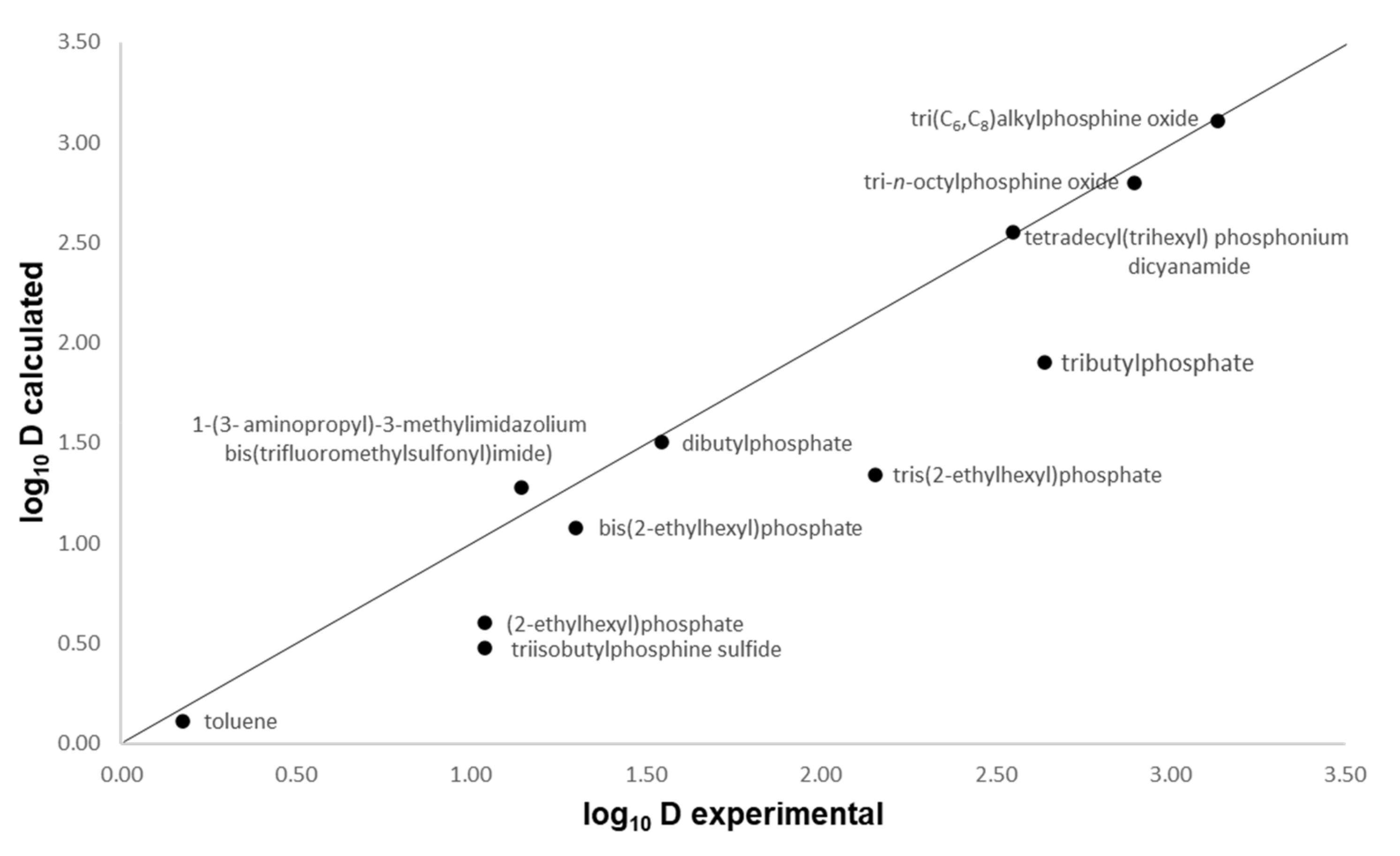
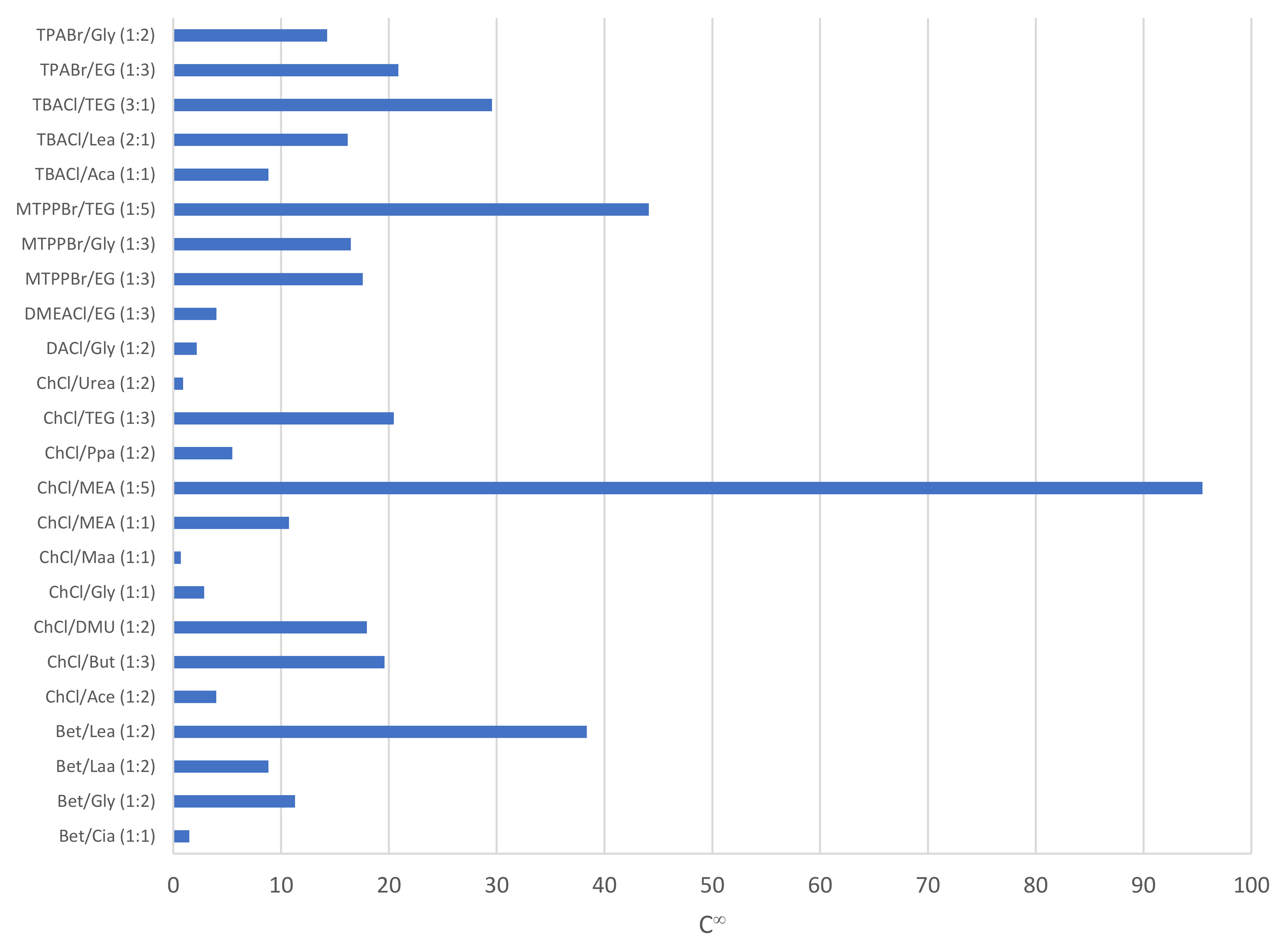
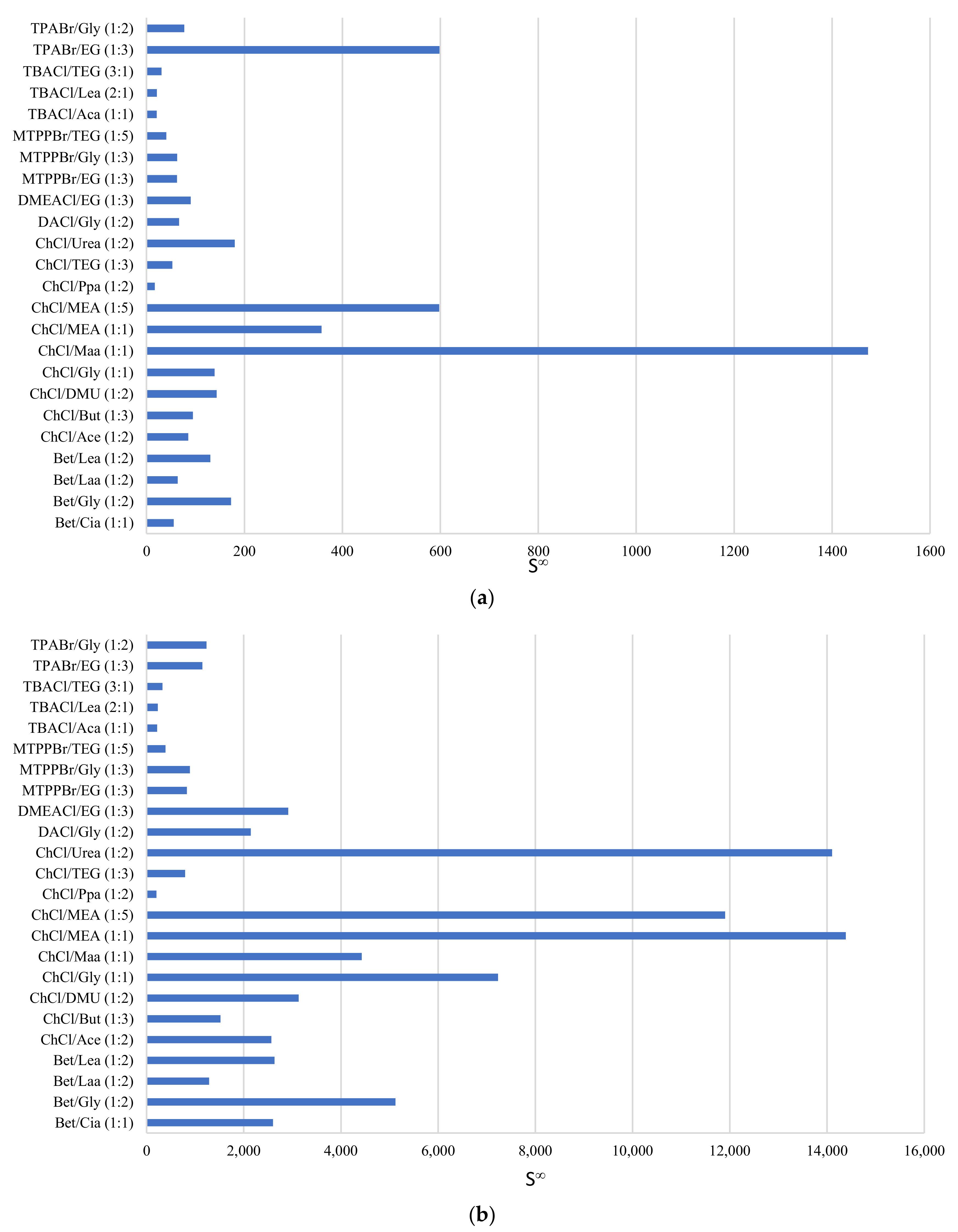
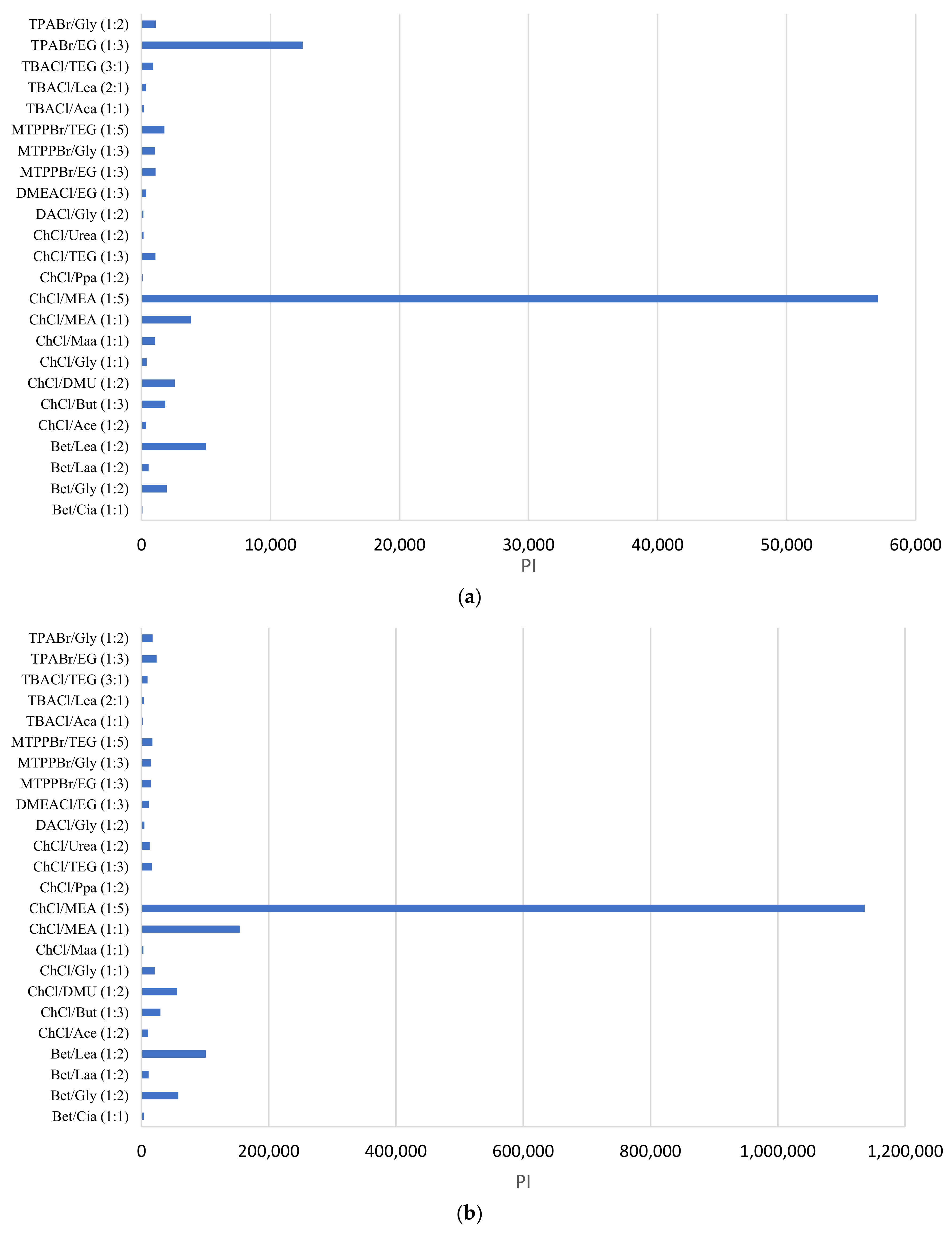
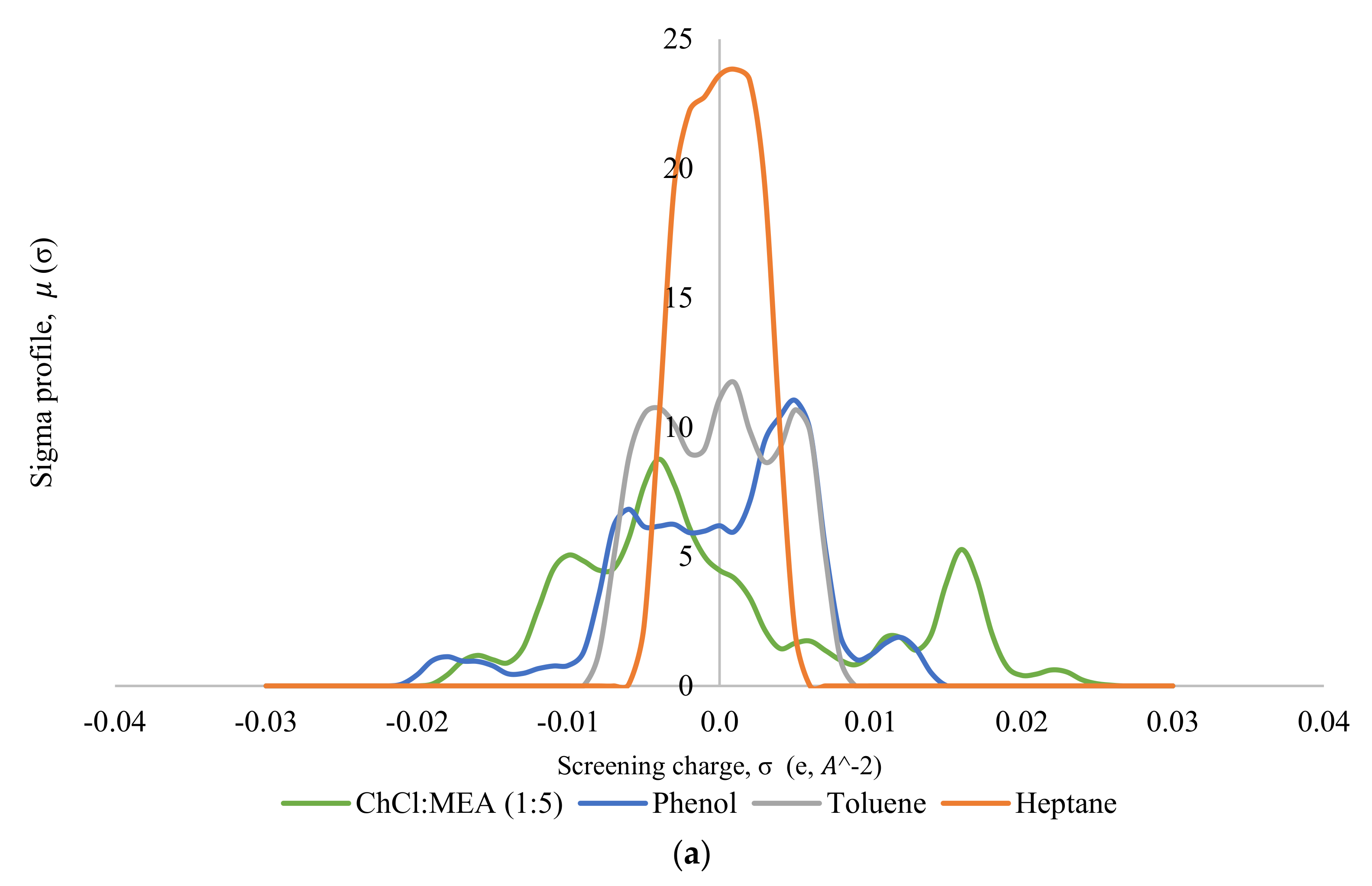
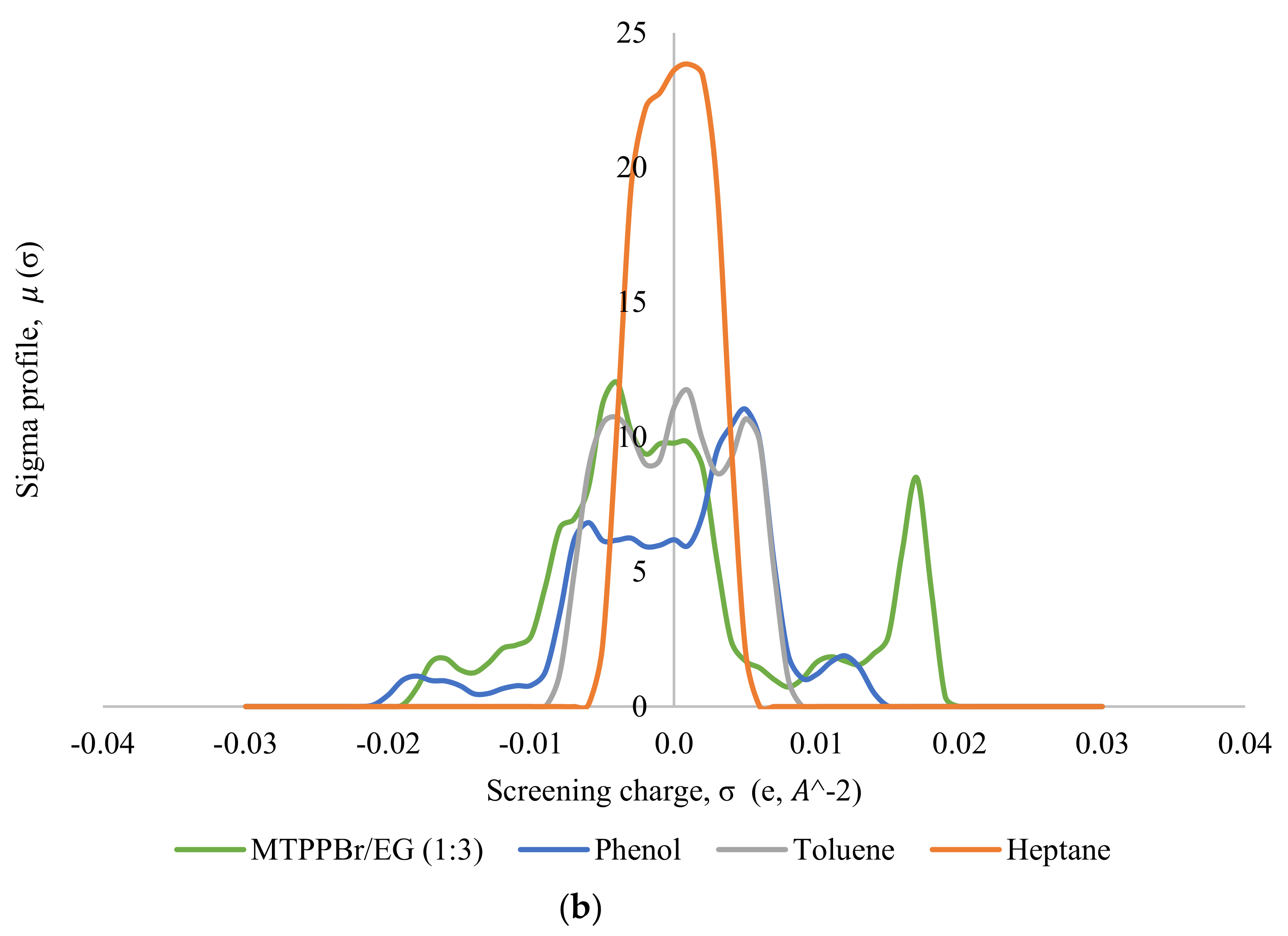
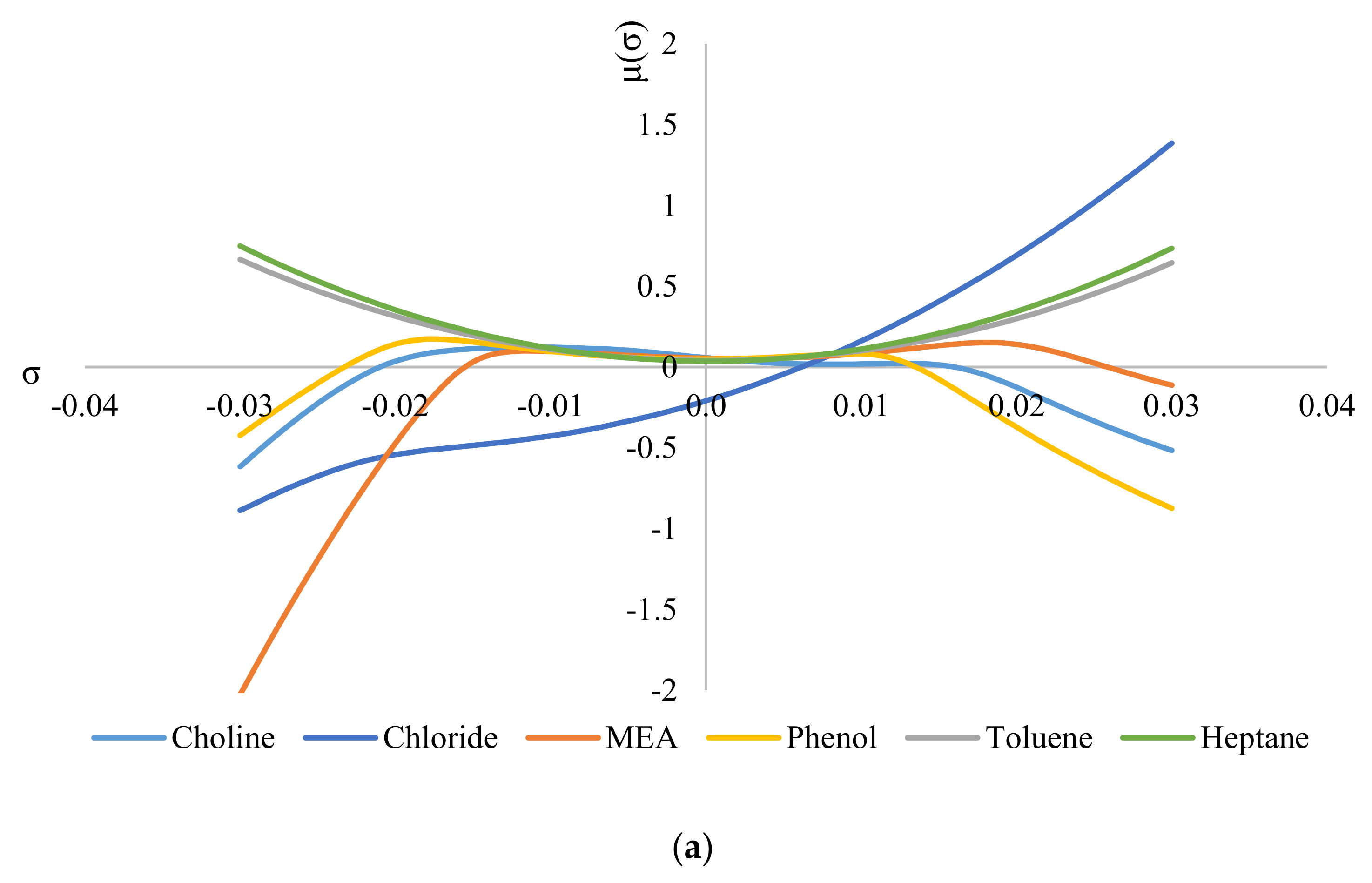
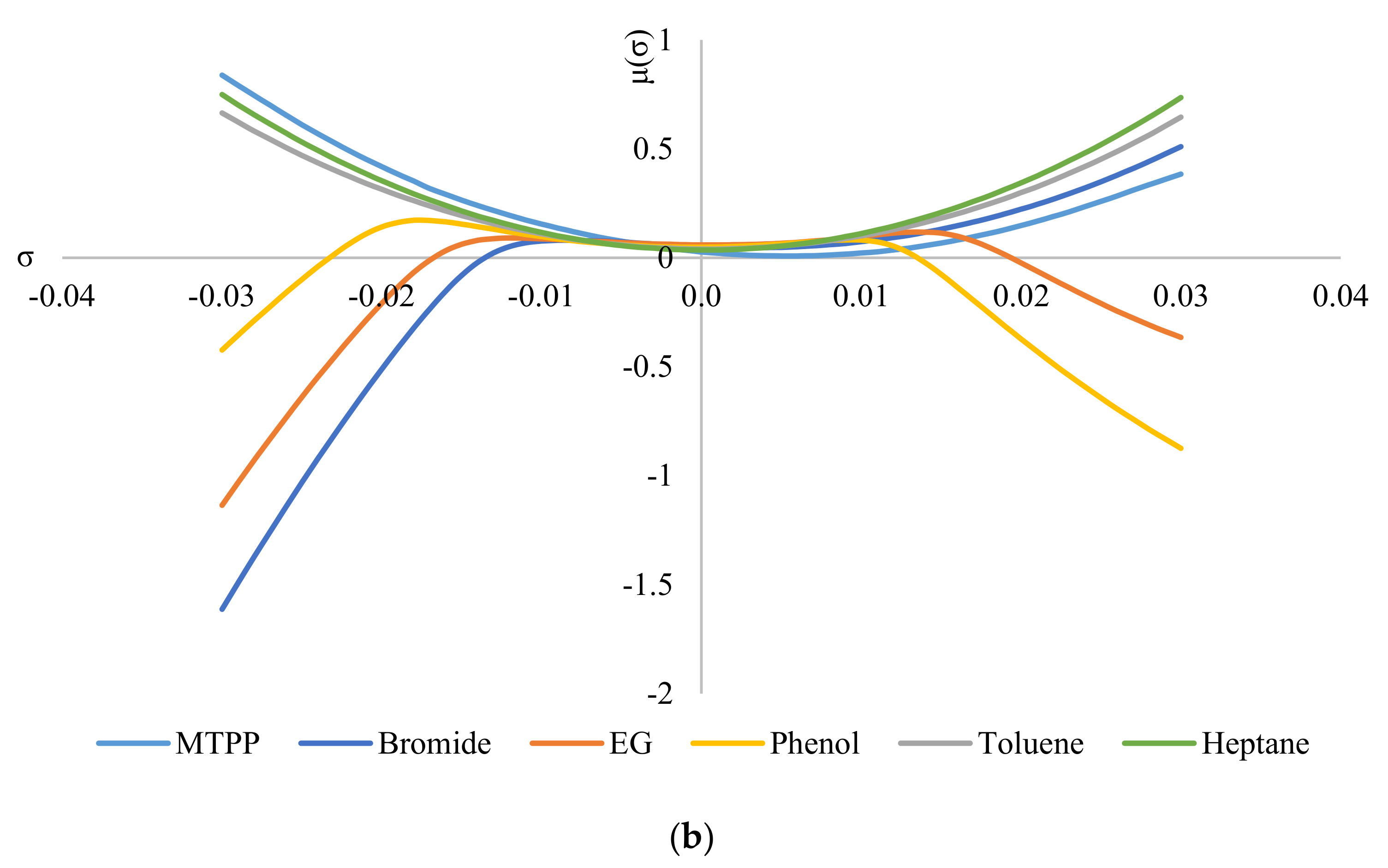
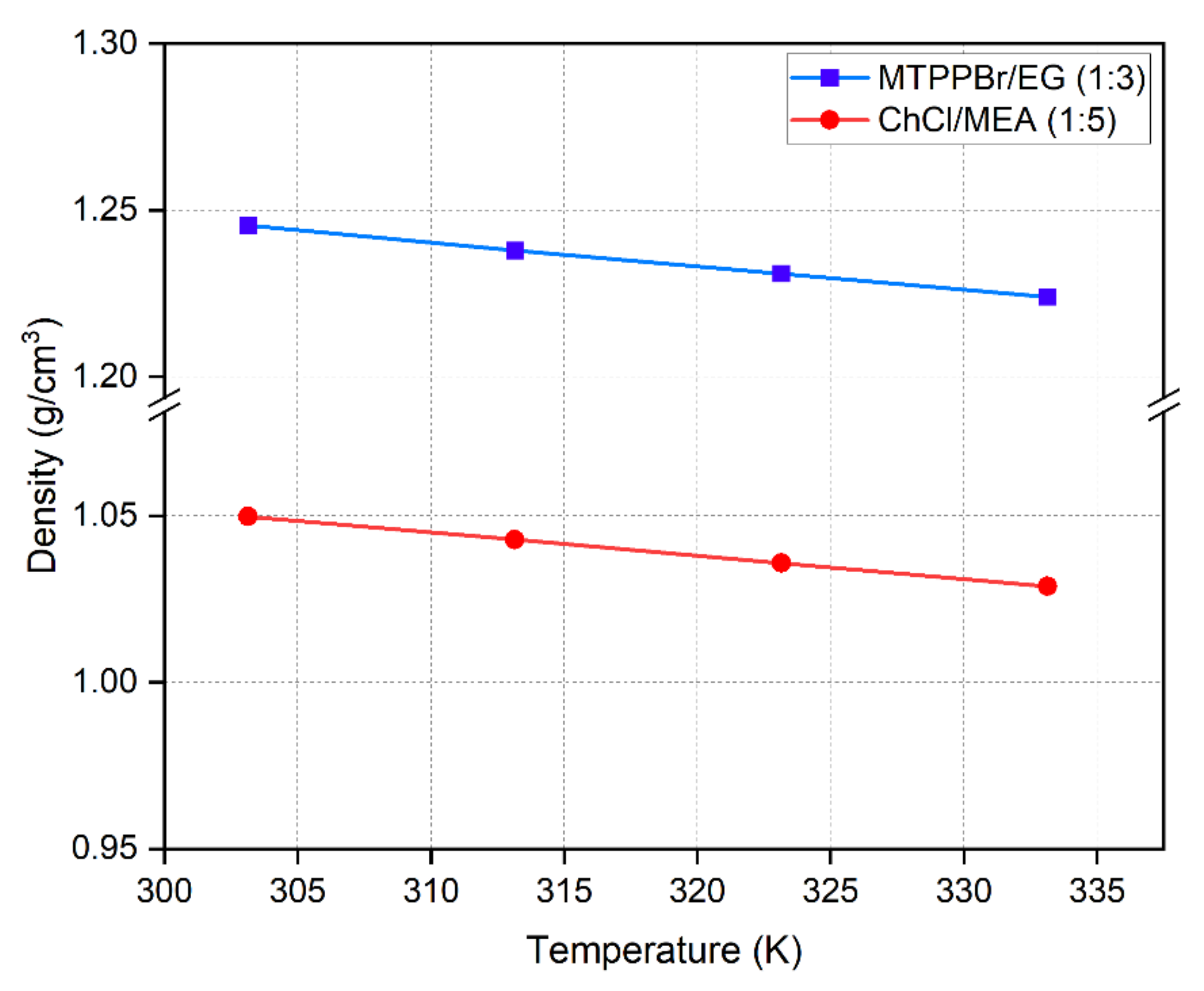
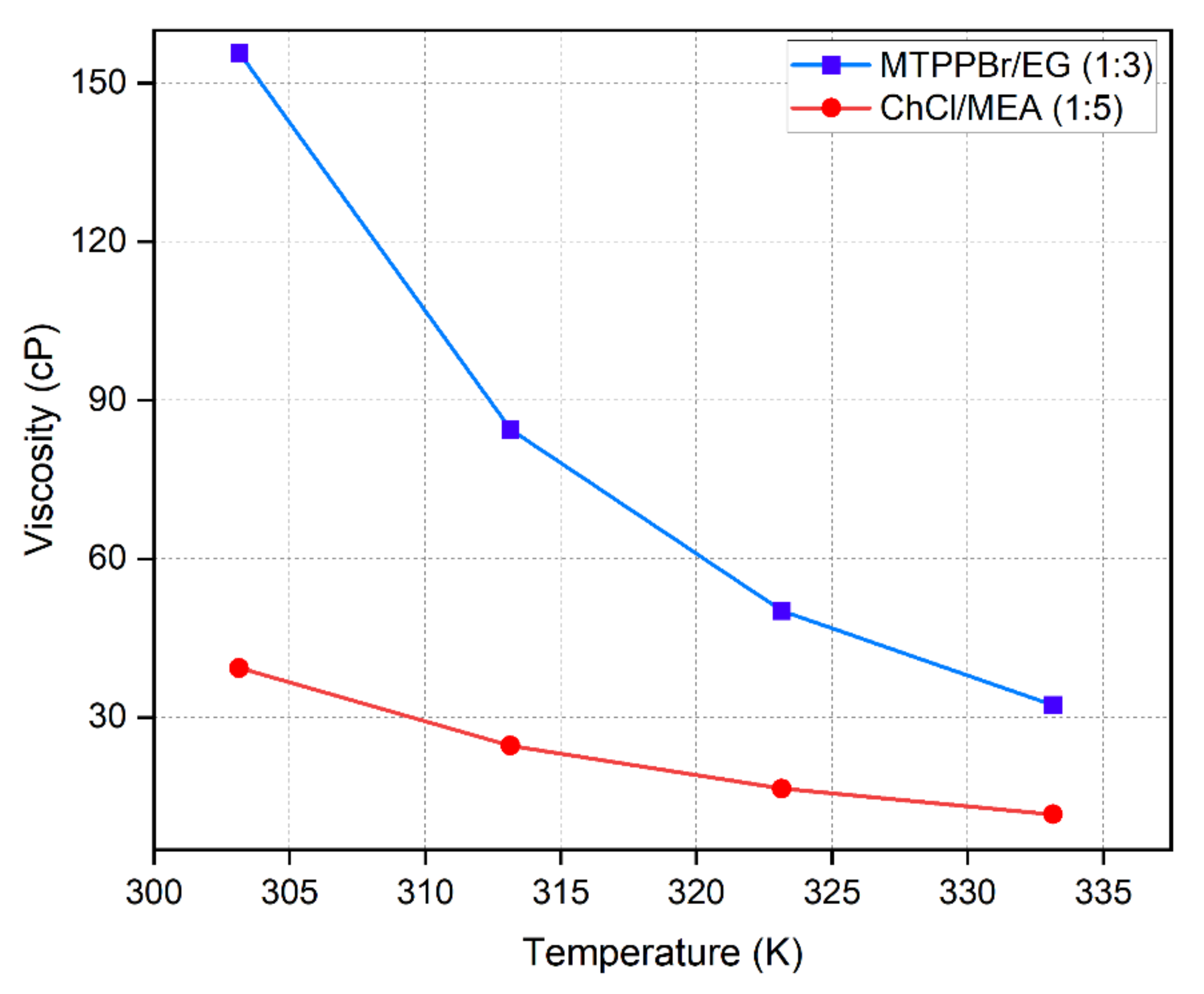
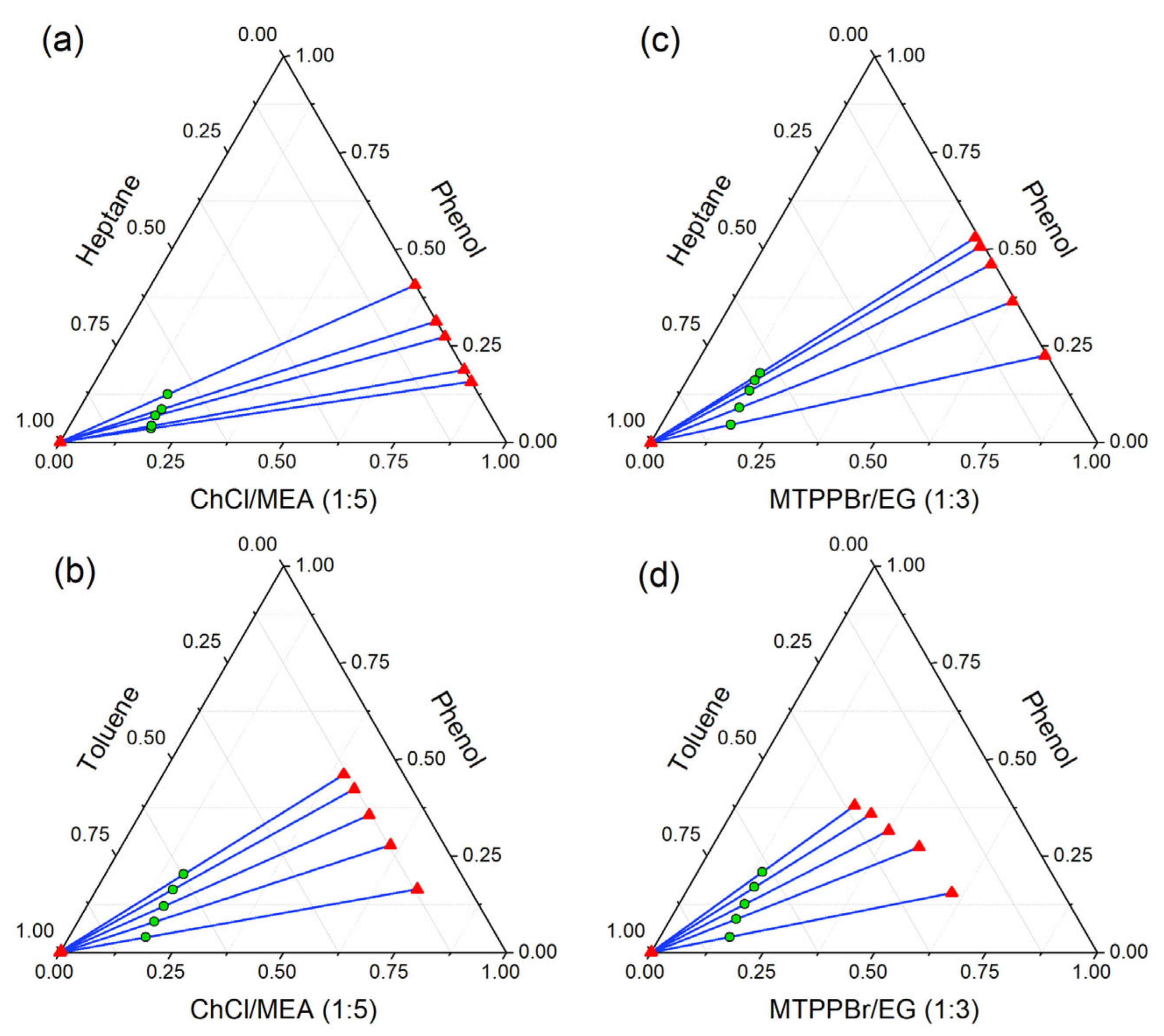
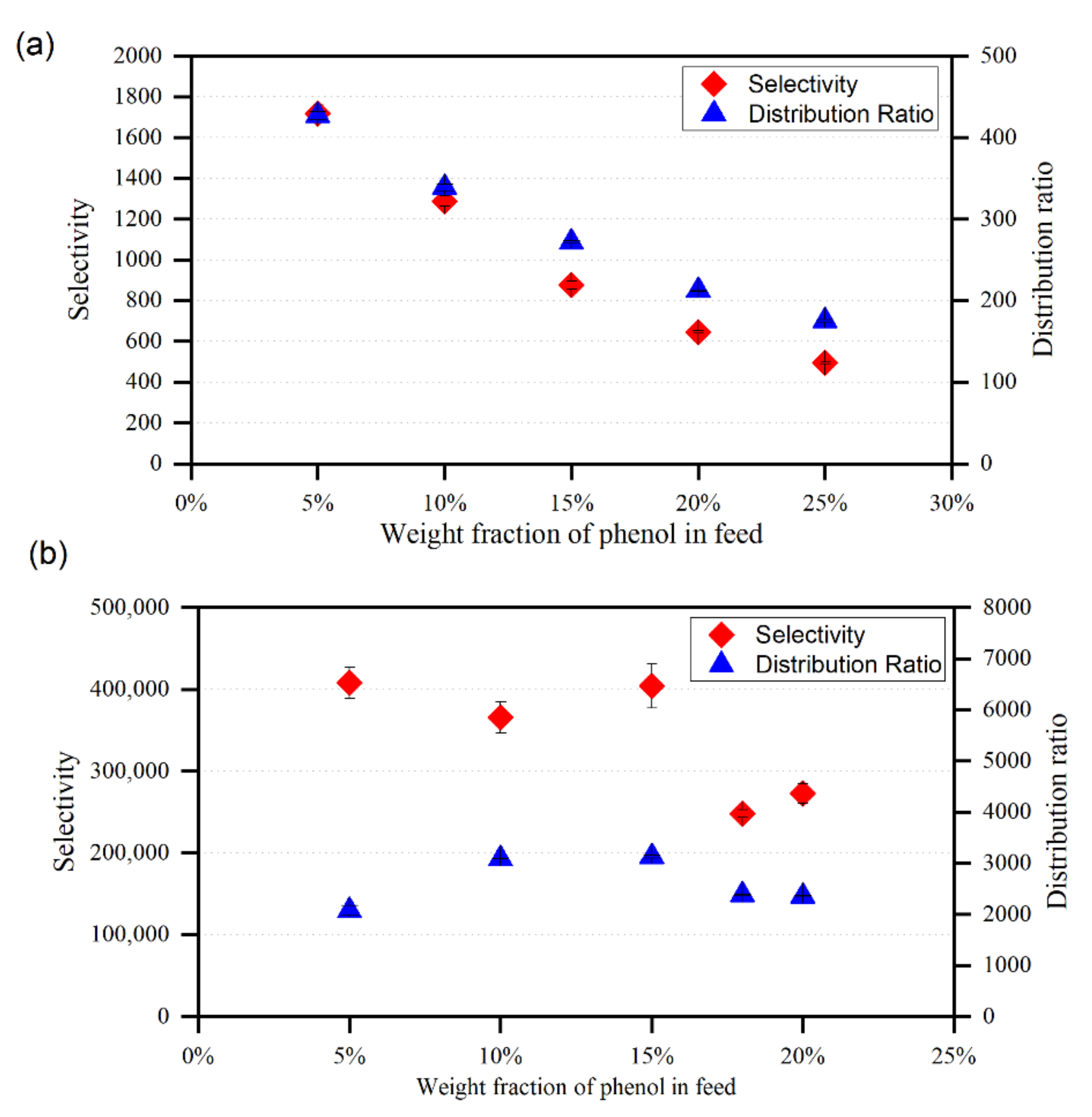
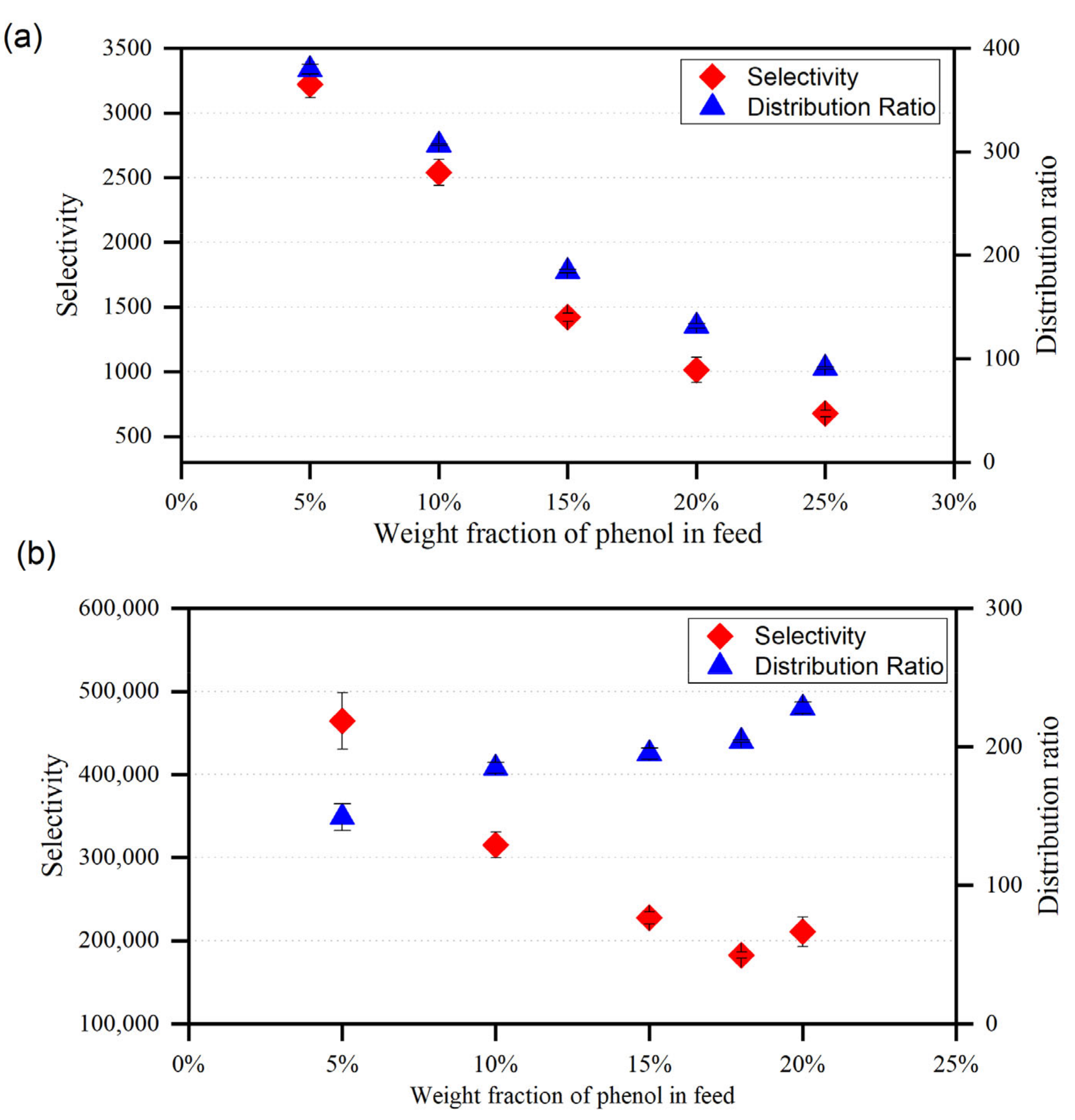
| Compound | Supplier | Purity |
|---|---|---|
| Toluene | VWR (Radnor, PA, USA) | 0.995 |
| n-heptane | Scharlau (Barcelona, Spain) | 0.99 |
| Phenol | Loba Chemie (Mumbai, India) | ≥0.99 |
| Ethylene glycol | Merck (Darmstadt, Germany) | 0.99 |
| Methyltriphenylphosphonium bromide | Acros Organics (Geel, Belgium) | ≥0.98 |
| Monoethanolamine | Sigma-Aldrich (Poole, UK) | ≥0.98 |
| Choline chloride | Acros Organics (Geel, Belgium) | 0.99 |
| Deuterated chloroform | Merck (Darmstadt, Germany) | ≥0.998 |
| Dimethyl sulfoxide-D6 | Merck (Darmstadt, Germany) | ≥0.998 |
| Parameter | Value |
|---|---|
| Temperature of injector (K) | 558.15 |
| Temperature of detector (K) | 558.15 |
| Carrier gas pressure (Kpa) | 60 |
| Oven program | 303.15 K for 4 min |
| 303.15 K to 473.15 K | |
| Rate: 20 K/min |
| No. | HBA | HBD | Abbreviation | References |
|---|---|---|---|---|
| 1 | Betaine | Glycerol | Bet/Gly (1:2) | [18] |
| 2 | Betaine | DL—lactic acid | Bet/Laa (1:2) | [18] |
| 3 | Betaine | Levulinic acid | Bet/Lea (1:2) | [18] |
| 4 | Betaine | Citric acid | Bet/Cia (1:1) | [21] |
| 5 | Choline chloride | Glycerol | ChCl/Gly (1:1) | [17] |
| 6 | Choline chloride | Malic acid | ChCl/Maa (1:1) | [17] |
| 7 | Choline chloride | Triethylene glycol | ChCl/TEG (1:3) | [17] |
| 8 | Choline chloride | Monoethanolamine | ChCl/MEA (1:1) | [17] |
| 9 | Choline chloride | Monoethanolamine | ChCl/MEA (1:5) | [22] |
| 10 | Choline chloride | Urea | ChCl/Urea (1:2) | [23] |
| 11 | Choline chloride | 1,1-dimethyl urea | ChCl/DMU (1:2) | [24] |
| 12 | Choline chloride | Phenylpropionic acid | ChCl/Ppa (1:2) | [25] |
| 13 | Choline chloride | Acetamide | ChCl/Ace (1:2) | [24] |
| 14 | Choline chloride | 1,4-butanediol | ChCl/However, (1:3) | [24] |
| 15 | Tetrabutylammonium chloride | Levulinic acid | TBACl/Lea (2:1) | [26] |
| 16 | Tetrabutylammonium chloride | Acetic acid | TBACl/Aca (1:1) | [26] |
| 17 | Tetrabutylammonium chloride | Triethylene glycol | TBACl/TEG (3:1) | [25] |
| 18 | Tetrapropylammonium bromide | Glycerol | TPABr/Gly (1:2) | [27] |
| 19 | Tetrapropylammonium bromide | Ethylene glycol | TPABr/EG (1:3) | [25] |
| 20 | N,N-diethylammonium chloride | Glycerol | DACl/Gly (1:2) | [25] |
| 21 | N,N-diethylethanolammonium chloride | Ethylene glycol | DEACl/EG (1:3) | [25] |
| 22 | Methyltriphenylphosphonium bromide | Glycerol | MTPPBr/Gly (1:3) | [25] |
| 23 | Methyltriphenylphosphonium bromide | Ethylene glycol | MTPPBr/EG (1:3) | [25] |
| 24 | Methyltriphenylphosphonium bromide | Triethylene glycol | MTPPBr/TEG (1:5) | [25] |
| DES-Rich Phase (Extract) | Hydrocarbon-Rich Phase (Raffinate) | D | ||||
|---|---|---|---|---|---|---|
| {toluene (1) + phenol (2) + MTPPBr/EG (1:3) (3)} | ||||||
| 0.2486 | 0.1552 | 0.5962 | 0.9996 | 0.0004 | 0 | 427 ± 5 |
| 0.2628 | 0.2739 | 0.4638 | 0.9992 | 0.0008 | 0 | 339 ± 4 |
| 0.3098 | 0.3159 | 0.3743 | 0.9988 | 0.0012 | 0 | 272 ± 2 |
| 0.3278 | 0.3590 | 0.3131 | 0.9983 | 0.0017 | 0 | 212 ± 2 |
| 0.3536 | 0.3818 | 0.2646 | 0.9978 | 0.0022 | 0 | 175 ± 2 |
| {heptane (1) + phenol (2) + MTPPBr/EG (1:3) (3)} | ||||||
| 0.0051 | 0.2248 | 0.7701 | 0.9999 | 0.0001 | 0 | 2081 ± 91 |
| 0.0084 | 0.3646 | 0.6270 | 0.9999 | 0.0001 | 0 | 3087 ± 4 |
| 0.0077 | 0.4614 | 0.5309 | 0.9999 | 0.0001 | 0 | 3128 ± 26 |
| 0.0096 | 0.5071 | 0.4834 | 0.9998 | 0.0002 | 0 | 2378 ± 6 |
| 0.0086 | 0.5301 | 0.4612 | 0.9998 | 0.0002 | 0 | 2356 ± 7 |
| {toluene (1) + phenol (2) + ChCl/MEA (1:5) (3)} | ||||||
| 0.1178 | 0.1639 | 0.7183 | 0.9996 | 0.0004 | 0 | 380 ± 4 |
| 0.1207 | 0.2788 | 0.6005 | 0.9991 | 0.0009 | 0 | 307 ± 2 |
| 0.1295 | 0.3567 | 0.5138 | 0.9981 | 0.0019 | 0 | 184 ± 2 |
| 0.1294 | 0.4235 | 0.4471 | 0.9968 | 0.0032 | 0 | 132 ± 3 |
| 0.1339 | 0.4612 | 0.4049 | 0.9949 | 0.0051 | 0 | 91 ± 1 |
| {heptane (1) + phenol (2) + ChCl/MEA (1:5) (3)} | ||||||
| 0.0003 | 0.1576 | 0.8421 | 0.9989 | 0.0011 | 0 | 149 ± 9 |
| 0.0006 | 0.1883 | 0.8111 | 0.9990 | 0.0010 | 0 | 185 ± 4 |
| 0.0009 | 0.2739 | 0.7253 | 0.9986 | 0.0014 | 0 | 195 ± 4 |
| 0.0011 | 0.3133 | 0.6856 | 0.9985 | 0.0015 | 0 | 204 ± 2 |
| 0.0011 | 0.4074 | 0.5915 | 0.9982 | 0.0018 | 0 | 228 ± 4 |
| 0.0003 | 0.1576 | 0.8421 | 0.9989 | 0.0011 | 0 | 149 ± 9 |
| Ternary System | Hand | Othmer-Tobias | ||||
|---|---|---|---|---|---|---|
| a | b | R2 | c | d | R2 | |
| MTPPBr/EG (1:3) + phenol + toluene | 1.046 | −4.684 | 0.998 | 1.257 | −5.144 | 0.995 |
| MTPPBr/EG (1:3) + phenol + heptane | 0.533 | −7.714 | 0.923 | 0.535 | −7.720 | 0.926 |
| ChCl/MEA (1:5) + phenol + toluene | 1.523 | −3.243 | 0.978 | 1.856 | −3.189 | 0.989 |
| ChCl/MEA (1:5) + phenol + heptane | 0.453 | −5.505 | 0.957 | 0.452 | −5.507 | 0.957 |
Publisher’s Note: MDPI stays neutral with regard to jurisdictional claims in published maps and institutional affiliations. |
© 2022 by the authors. Licensee MDPI, Basel, Switzerland. This article is an open access article distributed under the terms and conditions of the Creative Commons Attribution (CC BY) license (https://creativecommons.org/licenses/by/4.0/).
Share and Cite
Hizaddin, H.F.; Wazeer, I.; Huzaimi, N.A.M.; El Blidi, L.; Hashim, M.A.; Lévêque, J.-M.; Hadj-Kali, M.K. Extraction of Phenolic Compound from Model Pyrolysis Oil Using Deep Eutectic Solvents: Computational Screening and Experimental Validation. Separations 2022, 9, 336. https://doi.org/10.3390/separations9110336
Hizaddin HF, Wazeer I, Huzaimi NAM, El Blidi L, Hashim MA, Lévêque J-M, Hadj-Kali MK. Extraction of Phenolic Compound from Model Pyrolysis Oil Using Deep Eutectic Solvents: Computational Screening and Experimental Validation. Separations. 2022; 9(11):336. https://doi.org/10.3390/separations9110336
Chicago/Turabian StyleHizaddin, Hanee F., Irfan Wazeer, Nur Afrina Muhammad Huzaimi, Lahssen El Blidi, Mohd Ali Hashim, Jean-Marc Lévêque, and Mohamed K. Hadj-Kali. 2022. "Extraction of Phenolic Compound from Model Pyrolysis Oil Using Deep Eutectic Solvents: Computational Screening and Experimental Validation" Separations 9, no. 11: 336. https://doi.org/10.3390/separations9110336





